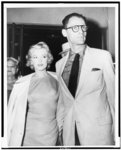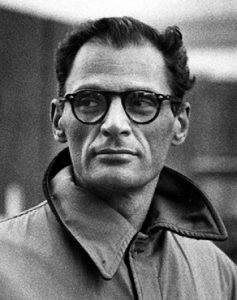parents Isidore Miller and Augusta Barnett. Initially well off, the family faced hardship at the
onset of the Great Depression, prompting their move from Manhattan to Brooklyn. Arthur
finished high school with a lackluster record, but he developed an interest in writing and began attending the University of Michigan to pursue this interest in 1934.
After trying short stories and journalism, Miller began writing drama, and won two
successive Hopwood Awards for plays written at the university before winning the Theater Guild National Award for The Grass Still Grows in 1938. This year also marked his graduation and return to New York, where he was joined by his soon to be wife Mary Grace Slattery. He worked many jobs upon his return, including a stint at the Federal Theatre Project.
All the Luck, in 1944. The play did poorly and closed after four performances. Miller wrote a novel, Focus, to examine anti-Semitism while grappling with his dramatic failure. Positive
reviews of his novel led Miller to write All My Sons, a last ditch effort to make it in to the
Broadway stage. The tale of war profiteering and family was wildly successful and led to the New York Drama Critics’ Circle Award of 1947, and it marked the first collaboration of Miller with director Elia Kazan.
 Miller gained a name for himself writing plays about people and their failures. He examined contemporary issues but did not criticize society. In 1949, Death of a Salesman (Willy Loman depicted in the sketch to the left) opened on Broadway, throwing Aristotelian caution to the wind as he stylized the tragedy of the common man. Many scholars notice the similarities between the Loman family and Miller’s, but it is undeniable that this Pulitzer Prize winning play was a feat of American theatre. With the succession of All My Sons and Death of a Salesman, Miller’s legacy was secure.
Miller gained a name for himself writing plays about people and their failures. He examined contemporary issues but did not criticize society. In 1949, Death of a Salesman (Willy Loman depicted in the sketch to the left) opened on Broadway, throwing Aristotelian caution to the wind as he stylized the tragedy of the common man. Many scholars notice the similarities between the Loman family and Miller’s, but it is undeniable that this Pulitzer Prize winning play was a feat of American theatre. With the succession of All My Sons and Death of a Salesman, Miller’s legacy was secure.Miller’s next works, An Enemy of the People and The Crucible, blatantly criticized the
onset of McCarthyism and the House Committee on Un-American Activities (HUAC). The
Crucible faced tentative audiences in the social context of the era, but won a Tony award and is highly celebrated today. Some argue the play would have done better under direction from Kazan, but Miller and the director’s relationship waned in previous years.
Kazan introduced Miller to his mistress Marilyn Monroe, who went on to have an affair
with Miller himself. In 1952, Kazan named names in front of HUAC, provoking the alienation and disgust of Miller as he wrote The Crucible.
 By the mid 1950’s, rumors floated that Miller’s prowess as a playwright was diminishing. In 1956, HUAC called Miller to testify. Monroe accompanied him to the hearing, and the two (pictured right) married later that year in June. Miller wrote his new wife a screenplay entitled The Misfits, but the marriage began to break up during its production in 1961. Miller had married Inge Morath within a year. Later plays include After the Fall and Incident at Vichy. In 1965, he became president of PENInternational to help dissident writers worldwide. Miller’s image declined throughout the rest of his life, but he continued writing plays with minimal success. He died on February 10, 2005, leaving behind a legacy as one of the preeminent playwrights of the American stage.
By the mid 1950’s, rumors floated that Miller’s prowess as a playwright was diminishing. In 1956, HUAC called Miller to testify. Monroe accompanied him to the hearing, and the two (pictured right) married later that year in June. Miller wrote his new wife a screenplay entitled The Misfits, but the marriage began to break up during its production in 1961. Miller had married Inge Morath within a year. Later plays include After the Fall and Incident at Vichy. In 1965, he became president of PENInternational to help dissident writers worldwide. Miller’s image declined throughout the rest of his life, but he continued writing plays with minimal success. He died on February 10, 2005, leaving behind a legacy as one of the preeminent playwrights of the American stage.Source: Keene, Ann T. “Miller, Arthur.” American National Biography Online, Oxford
University Press, 2000.
Images: Upper left and right: Courtesy of playbill.com Below Left: Block, Herbert, Artist. Death of a salesman / Herblock. Photograph. Retrieved from the Library of Congress, <https://www.loc.gov/item/2006682398/>. Lower right: Monroe and Miller depart for London. Photograph. Retrieved from the Library of Congress, <https://www.loc.gov/item/94509075/>.


